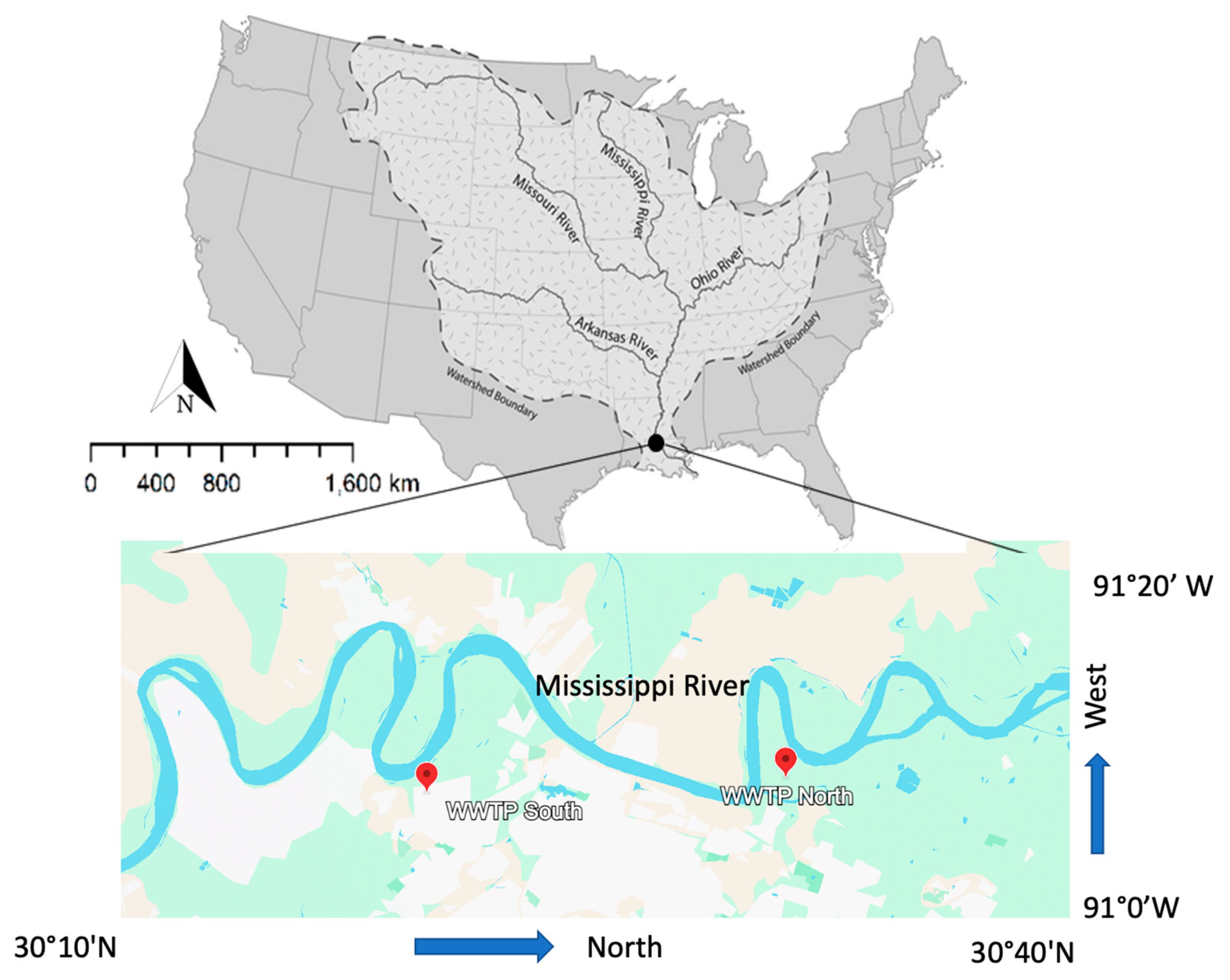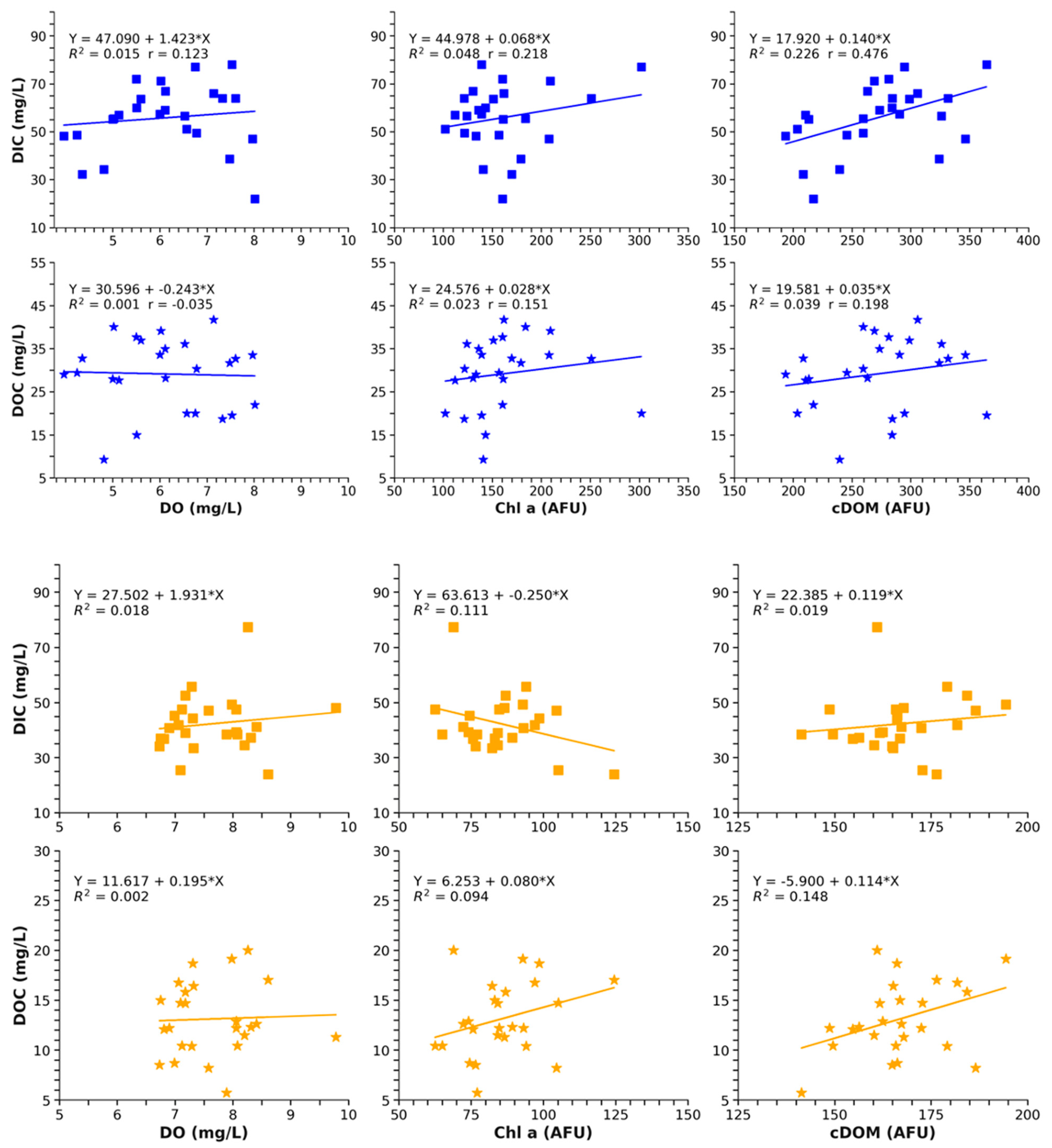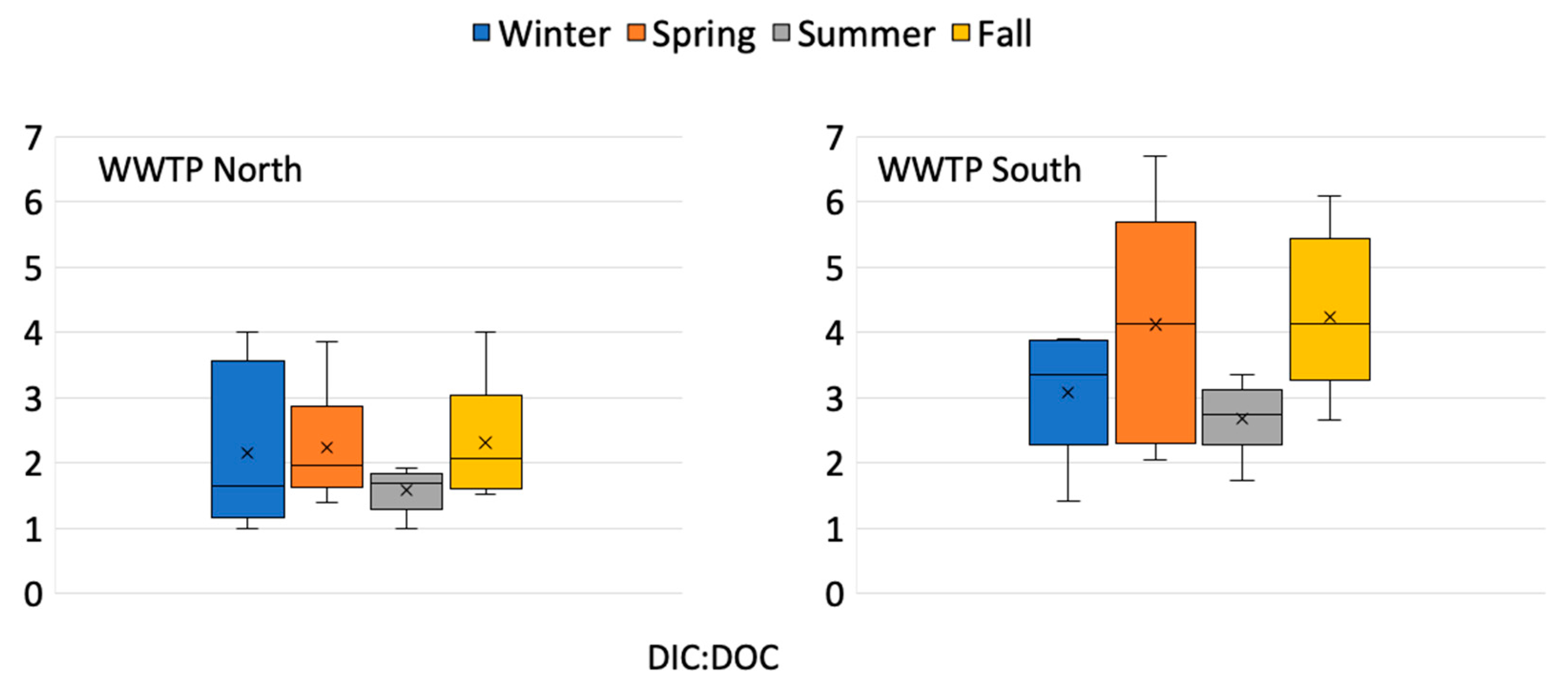Effluent Dissolved Carbon Discharge from Two Municipal Wastewater Treatment Plants to the Mississippi River
Abstract
1. Introduction
2. Materials and Methods
2.1. Study Site
2.2. Field Measurements and Sampling
2.3. Chemical Analysis for DIC and DOC
2.4. Estimation of Effluent DIC and DOC Mass Loading
2.5. Statistical Analysis
3. Results
3.1. Physicochemical Parameters
3.2. Dissolved Carbon Concentrations
3.3. Annual Dissolved Carbon Loads from WWTP Effluents
3.4. Relations of Effluent Dissolved Carbon with Water Physiological Variables
4. Discussion
4.1. High Legacy Carbon from WWTP Effluents
4.2. Temporal Variation of Effluent Carbon
4.3. Implications of WWTP Effluent Carbon at a River Basin Scale
5. Conclusions
Author Contributions
Funding
Data Availability Statement
Acknowledgments
Conflicts of Interest
References
- Carey, R.O.; Migliaccio, K.W. Contribution of wastewater treatment plant effluents to nutrient dynamics in aquatic systems: A review. Environ. Manag. 2009, 44, 205–217. [Google Scholar] [CrossRef] [PubMed]
- Bouwman, A.F.; Van Drecht, G.; Knoop, J.M.; Beusen, A.H.W.; Meinardi, C.R. Exploring changes in river nitrogen export to the world’s oceans. Glob. Biogeochem. Cycles 2005, 19. [Google Scholar] [CrossRef]
- Beusen, A.H.; Bouwman, A.F.; Van Beek, L.P.; Mogollón, J.M.; Middelburg, J.J. Global riverine N and P transport to ocean increased during the 20th century despite increased retention along the aquatic continuum. Biogeosciences 2016, 13, 2441–2451. [Google Scholar] [CrossRef]
- Rectenwald, L.L.; Drenner, R.W. Nutrient removal from wastewater effluent using an ecological water treatment system. Environ. Sci. Technol. 2000, 34, 522–526. [Google Scholar] [CrossRef]
- Hendriks, A.T.; Langeveld, J.G. Rethinking wastewater treatment plant effluent standards: Nutrient reduction or nutrient control? Environ. Sci. Technol. 2017, 51, 4735–4737. [Google Scholar] [CrossRef]
- Eissa, A.E.; Zaki, M.M. The impact of global climatic changes on the aquatic environment. Procedia Environ. Sci. 2011, 4, 251–259. [Google Scholar] [CrossRef]
- Battin, T.J.; Lauerwald, R.; Bernhardt, E.S.; Bertuzzo, E.; Gener, L.G.; Hall, R.O., Jr.; Hotchkiss, E.R.; Maavara, T.; Pavelsky, T.M.; Ran, L.; et al. River ecosystem metabolism and carbon biogeochemistry in a changing world. Nature 2023, 613, 449–459. [Google Scholar] [CrossRef]
- Yoon, T.K.; Jin, H.; Begum, M.S.; Kang, N.; Park, J.-H. CO2 Outgassing from an Urbanized River System Fueled by Wastewater Treatment Plant Effluents. Environ. Sci. Technol. 2017, 51, 10459–10467. [Google Scholar] [CrossRef]
- Worrall, F.; Howden, N.; Burt, T.; Bartlett, R. The importance of sewage effluent discharge in the export of dissolved organic carbon from U.K. rivers. Hydrol. Process. 2019, 33, 1851–1864. [Google Scholar] [CrossRef]
- Li, M.; Peng, C.; Wang, M.; Xue, W.; Zhang, K.; Wang, K.; Shi, G.; Zhu, Q. The carbon flux of global rivers: A re-evaluation of amount and spatial patterns. Ecol. Indic. 2017, 80, 40–51. [Google Scholar] [CrossRef]
- Xu, Y.J.; Xu, Z.; Potter, L. Connectivity of floodplain influences riverine carbon outgassing and dissolved carbon transport. Sci. Total Environ. 2024, 924, 171604. [Google Scholar] [CrossRef]
- Jones, E.R.; Van Vliet, M.T.; Qadir, M.; Bierkens, M.F. Country-level and gridded estimates of wastewater production, collection, treatment and reuse. Earth Syst. Sci. Data 2021, 13, 237–254. [Google Scholar] [CrossRef]
- Macedo, H.; Lehner, B.; Nicell, J.; Grill, G.; Li, J.; Limtong, A.; Shakya, R. Distribution and characteristics of wastewater treatment plants within the global river network. Earth Syst. Sci. Data 2022, 14, 559–577. [Google Scholar] [CrossRef]
- Available online: https://www.mohurd.gov.cn/gongkai/fdzdgknr/sjfb/index.html (accessed on 1 June 2025).
- Available online: http://www.mwr.gov.cn/sj/tjgb/szygb/202306/t20230630_1672556.html (accessed on 1 June 2025).
- U.S. Environmental Protection Agency (EPA). Clean Watersheds Needs Survey (CWNS) 2022 Report. 2022. Available online: https://www.epa.gov/cwns (accessed on 29 August 2025).
- Reiman, J.H.; Xu, Y.J. Diel Variability of pCO2 and CO2 Outgassing from the Lower Mississippi River: Implications for Riverine CO2 Outgassing Estimation. Water 2019, 11, 43. [Google Scholar] [CrossRef]
- Wang, J.; Wang, X.; Liu, T.; Yuan, X.; Chen, H.; He, Y.; Wu, S.; Yuan, Z.; Li, H.; Que, Z.; et al. pCO2 and CO2 evasion from two small suburban rivers: Implications of the watershed urbanization process. Sci. Total Environ. 2021, 788, 147787. [Google Scholar] [CrossRef] [PubMed]
- Barnes, R.T.; Raymond, P.A. The contribution of agricultural and urban activities to inorganic carbon fluxes within temperate watersheds. Chem. Geol. 2009, 266, 318–327. [Google Scholar] [CrossRef]
- Cai, W.; Jiao, N. Wastewater alkalinity addition as a novel approach for ocean negative carbon emissions. Innovation 2022, 3, 100272. [Google Scholar] [CrossRef]
- Cao, X.; Xu, Y.J.; Long, G.; Wu, P.; Liu, Z. Dissolved carbon in effluent of wastewater treatment plants and its potential impacts in the receiving karst river. Environ. Res. 2024, 251, 118570. [Google Scholar] [CrossRef]
- City of Baton Rouge. (n.d.). Available online: https://city.brla.gov/press/arounddet.asp?gid=2590 (accessed on 5 August 2025).
- Aitkenhead-Peterson, J.A.; Steele, M.K.; Nahar, N.; Santhy, K. Dissolved organic carbon and nitrogen in urban and rural watersheds of south-central Texas: Land use and land management influences. Biogeochemistry 2009, 96, 119–129. [Google Scholar] [CrossRef]
- Alshboul, Z.; Encinas-Fernández, J.; Hofmann, H.; Lorke, A. Export of Dissolved Methane and Carbon Dioxide with Effluents from Municipal Wastewater Treatment Plants. Environ. Sci. Technol. 2016, 50, 5555–5563. [Google Scholar] [CrossRef]
- Li, Z.; Sun, Z.; Zhang, L.; Zhan, N.; Lou, C.; Lian, J. Investigation of water quality and aquatic ecological succession of a newly constructed river replenished by reclaimed water in Beijing. Heliyon 2023, 9, e17045. [Google Scholar] [CrossRef]
- Cao, X.; Chen, S.; Liu, Y.; Long, G.; Xu, Y.J. Domestic wastewater is an overlooked source and quantity in global river dissolved carbon. Nat. Commun. 2025, 16, 7522. [Google Scholar] [CrossRef] [PubMed]
- Raymond, P.; Hartmann, J.; Lauerwald, R.; Sobek, S.; McDonald, C.; Hoover, M.; Butman, D.; Striegl, R.; Mayorga, E.; Humborg, C.; et al. Global carbon dioxide emissions from inland waters. Nature 2013, 503, 355–359. [Google Scholar] [CrossRef] [PubMed]
- Wanninkhof, R.; Asher, W.E.; Ho, D.T.; Sweeney, C.; McGillis, W.R. Advances in Quantifying Air-Sea Gas Exchange and Environmental Forcing. Annu. Rev. Mar. Sci. 2009, 1, 213–244. [Google Scholar] [CrossRef] [PubMed]
- Dristi, A.; Xu, Y.J. Large Uncertainties in CO2 Water–Air Outgassing Estimation with Gas Exchange Coefficient KT for a Large Lowland River. Water 2023, 15, 14. [Google Scholar] [CrossRef]
- Keen, O.S.; McKay, G.; Mezyk, S.P.; Linden, K.G.; Rosario-Ortiz, F.L. Identifying the factors that influence the reactivity of effluent organic matter with hydroxyl radicals. Water Res. 2014, 50, 408–419. [Google Scholar] [CrossRef] [PubMed]
- Miller, P.W.; Hiatt, M. Hydrometeorological Drivers of the 2023 Louisiana Water Crisis. Geophys. Res. Lett. 2024, 5, e2024GL108545. [Google Scholar] [CrossRef]
- Dristi, A.; Ran, L.; Li, S.; Xu, Y.J. Carbon dioxide emission and dissolved carbon transport of a large lowland river entering the Gulf of Mexico under hydrological drought. Estuar. Coast. Shelf Sci. 2025, 324, 109465. [Google Scholar] [CrossRef]
- Aparicio-Ugarriza, R.; Rumi, C.; Luzardo-Socorro, R.; Mielgo-Ayuso, J.; Palacios, G.; Bibiloni, M.D.M.; González-Gross, M. Seasonal variation and diet quality among Spanish people aged over 55 years. J. Physiol. Biochem. 2018, 74, 179–188. [Google Scholar] [CrossRef]
- Kucukerdonmez, O.; Rakicioglu, N. The effect of seasonal variations on food consumption, dietary habits, anthropometric measurements and serum vitamin levels of university students. Prog. Nutr. 2018, 20, 165–175. [Google Scholar]
- Loraine, G.A.; Pettigrove, M.E. Seasonal variations in concentrations of pharmaceuticals and personal care products in drinking water and reclaimed wastewater in southern California. Environ. Sci. Technol. 2006, 40, 687–695. [Google Scholar] [CrossRef]
- Sui, Q.; Huang, J.; Deng, S.; Chen, W.; Yu, G. Seasonal variation in the occurrence and removal of pharmaceuticals and personal care products in different biological wastewater treatment processes. Environ. Sci. Technol. 2011, 45, 3341–3348. [Google Scholar] [CrossRef]
- Bayo, J.; López-Castellanos, J.; Puerta, J. Operational and environmental conditions for efficient biological nutrient removal in an urban wastewater treatment plant. CLEAN–Soil Air Water 2016, 44, 1123–1130. [Google Scholar] [CrossRef]
- Sari, S.; Ozdemir, G.; Yangin-Gomec, C.; Zengin, G.E.; Topuz, E.; Aydin, E.; Pehlivanoglu-Mantas, E.; Tas, D.O. Seasonal variation of diclofenac concentration and its relation with wastewater characteristics at two municipal wastewater treatment plants in Turkey. J. Hazard. Mater. 2014, 272, 155–164. [Google Scholar] [CrossRef]
- Devlin, M.; Brodie, J. Nutrients and eutrophication. In Marine Pollution–Monitoring, Management and Mitigation; Springer Nature Switzerland: Cham, Switzerland, 2023; pp. 75–100. [Google Scholar]
- Song, C.; Ballantyne, F., IV; Smith, V.H. Enhanced dissolved organic carbon production in aquatic ecosystems in response to elevated atmospheric CO2. Biogeochemistry 2014, 118, 49–60. [Google Scholar] [CrossRef]
- Merlivat, L.; Boutin, J.; Antoine, D.; Beaumont, L.; Golbol, M.; Vellucci, V. Increase of dissolved inorganic carbon and decrease in pH in near-surface waters in the Mediterranean Sea during the past two decades. Biogeosciences 2018, 15, 5653–5662. [Google Scholar] [CrossRef]
- Justić, D.; Rabalais, N.N.; Turner, R.E. Coupling between climate variability and coastal eutrophication: Evidence and outlook for the northern Gulf of Mexico. J. Sea Res. 2005, 54, 25–35. [Google Scholar] [CrossRef]
- Turner, R.E.; Rabalais, N.N.; Justic, D. Gulf of Mexico hypoxia: Alternate states and a legacy. Environ. Sci. Technol. 2008, 42, 2323–2327. [Google Scholar] [CrossRef] [PubMed]
- Rabalais, N.N.; Turner, R.E.; Wiseman, W.J., Jr. Gulf of Mexico hypoxia, aka “The dead zone”. Annu. Rev. Ecol. Syst. 2002, 33, 235–263. [Google Scholar] [CrossRef]
- Fry, B.; Justić, D.; Riekenberg, P.; Swenson, E.M.; Turner, R.E.; Wang, L.; Pride, L.; Rabalais, N.N.; Kurtz, J.C.; Lehrter, J.C.; et al. Carbon dynamics on the Louisiana continental shelf and cross-shelf feeding of hypoxia. Estuaries Coasts 2015, 38, 703–721. [Google Scholar] [CrossRef]
- Trefry, J.H.; Metz, S.; Nelsen, T.A.; Trocine, R.P.; Eadie, B.J. Transport of particulate organic carbon by the Mississippi River and its fate in the Gulf of Mexico. Estuaries 1994, 17, 839–849. [Google Scholar] [CrossRef]
- Bauer, J.E.; Cai, W.J.; Raymond, P.A.; Bianchi, T.S.; Hopkinson, C.S.; Regnier, P.A. The changing carbon cycle of the coastal ocean. Nature 2013, 504, 61–70. [Google Scholar] [CrossRef]
- Cai, W.-J. Estuarine and coastal ocean carbon paradox: CO2 sinks or sites of terrestrial carbon incineration? Annu. Rev. Mar. Sci. 2011, 3, 123–145. [Google Scholar] [CrossRef] [PubMed]
- Crawford, J.T.; Loken, L.C.; Stanley, E.H.; Stets, E.G.; Dornblaser, M.M.; Striegl, R.G. Basin scale controls on CO2 and CH4 emissions from the Upper Mississippi River. Geophys. Res. Lett. 2016, 43, 1973–1979. [Google Scholar] [CrossRef]
- Zeng, F.-W.; Masiello, C.A.; Hockaday, W.C. Controls on the origin and cycling of riverine dissolved inorganic carbon in the Brazos River, Texas. Biogeochemistry 2011, 104, 275–291. [Google Scholar] [CrossRef]
- Li, S.; Luo, J.; Wu, D.; Jun Xu, Y. Carbon and nutrients as indictors of daily fluctuations of pCO2 and CO2 flux in a river draining a rapidly urbanizing area. Ecol. Indic. 2020, 109, 105821. [Google Scholar] [CrossRef]
- Reiman, J.; Xu, Y.J. Dissolved carbon export and CO2 outgassing from the lower Mississippi River–Implications of future river carbon fluxes. J. Hydrol. 2019, 578, 124093. [Google Scholar] [CrossRef]
- Yang, X.; Xue, L.; Li, Y.; Han, P.; Liu, X.; Zhang, L.; Cai, W.J. Treated wastewater changes the export of dissolved inorganic carbon and its isotopic composition and leads to acidification in coastal oceans. Environ. Sci. Technol. 2018, 52, 5590–5599. [Google Scholar] [CrossRef]
- Liu, X.; Yang, X.; Li, Y.; Zang, H.; Zhang, L. Variations in dissolved inorganic carbon species in effluents from large-scale municipal wastewater treatment plants (Qingdao, China) and their potential impacts on coastal acidification. Environ. Sci. Pollut. Res. 2019, 26, 15019–15027. [Google Scholar] [CrossRef]
- Xu, Y.J.; Cao, X.; Zhou, W. (under review) Effluent contribution of municipal wastewater treatment plants to the Mississippi River across its tributary basins. Water Res. Under Rev. 2025, under review. [Google Scholar]
- Drake, T.; Raymond, P.; Spencer, R. Terrestrial carbon inputs to inland waters: A current synthesis of estimates and uncertainty. Limnol. Oceanogr. Lett. 2018, 3, 132–142. [Google Scholar] [CrossRef]
- Gu, C.; Waldron, S.; Bass, A. Anthropogenic land use and urbanization alter the dynamics and increase the export of dissolved carbon in an urbanized river systems. Sci. Total Environ. 2022, 846, 157436. [Google Scholar] [CrossRef]
- Raymond, P.; Bauer, J. Use of 14C and 13C natural abundances for evaluating riverine, estuarine, and coastal DOC and POC sources and cycling: A review and synthesis. Org. Geochem. 2001, 32, 469–485. [Google Scholar] [CrossRef]







| WWTP | North | ||||||||
|---|---|---|---|---|---|---|---|---|---|
| Chl a | cDOM | NH4 | Turb | Temp | DO | pH | DIC | DOC | |
| Chl a | 1 | ||||||||
| cDOM | 0.36 | 1 | |||||||
| NH4 | 0.36 | 0.99 * | 1 | ||||||
| Turb | 0.25 | −0.28 | −0.27 | 1 | |||||
| Temp | −0.24 | −0.09 | −0.11 | 0.23 | 1 | ||||
| DO | 0.20 | 0.35 | 0.33 | −0.43 * | −0.37 | 1 | |||
| pH | 0.25 | 0.31 | 0.29 | −0.04 | −0.01 | −0.15 | 1 | ||
| DIC | 0.26 | 0.67 * | 0.63 * | −0.25 | −0.06 | −0.02 | 0.46 * | 1 | |
| DOC | 0.20 | 0.38 * | 0.37 | 0.14 | 0 | −0.10 | 0.51 * | 0.36 | 1 |
| WWTP | South | ||||||||
| Chl a | cDOM | NH4 | Turb | Temp | DO | pH | DIC | DOC | |
| Chl a | 1 | ||||||||
| cDOM | 0.53 * | 1 | |||||||
| NH4 | 0.22 | 0.64 * | 1 | ||||||
| Turb | 0.72 * | 0.22 | 0.13 | 1 | |||||
| Temp | −0.16 | 0.29 | 0.26 | −0.31 | 1 | ||||
| DO | 0.05 | −0.18 | −0.16 | 0.07 | −0.59 * | 1 | |||
| pH | −0.14 | 0.14 | −0.06 | −0.25 | −0.08 | 0.09 | 1 | ||
| DIC | −0.31 | 0.20 | −0.01 | −0.31 | 0.12 | 0.11 | 0.21 | 1 | |
| DOC | 0.28 | 0.25 | 0.11 | 0.48 * | −0.30 | 0.07 | 0.22 | 0.14 | 1 |
| Average DIC (mg/L) | Average DOC (mg/L) | Average Effluent (m3/day) | DIC Load (MT/day) | DOC Load (MT/day) | Total DC (MT/day) | |
|---|---|---|---|---|---|---|
| WWTP North | 56.80 ± 16.51 | 29.52 ± 8.68 | 6.74 × 104 | 3.80 | 1.95 | 5.75 |
| WWTP South | 42.64 ± 10.50 | 12.93 ± 3.68 | 14.85 × 104 | 6.27 | 1.92 | 8.19 |
| Total | 10.07 | 3.87 | 13.94 |
| Sites | Average DIC mg/L | Average DOC mg/L | DIC:DOC |
|---|---|---|---|
| WWTP North | 56.80 ± 16.51 a | 29.52 ± 8.64 a | 1.92 a |
| WWTP South | 42.64 ± 10.50 b | 12.93 ± 3.68 b | 3.29 b |
| LMR | 28.92 ± 4.91 c | 5.47 ± 2.35 c | 5.89 c |
Disclaimer/Publisher’s Note: The statements, opinions and data contained in all publications are solely those of the individual author(s) and contributor(s) and not of MDPI and/or the editor(s). MDPI and/or the editor(s) disclaim responsibility for any injury to people or property resulting from any ideas, methods, instructions or products referred to in the content. |
© 2025 by the authors. Licensee MDPI, Basel, Switzerland. This article is an open access article distributed under the terms and conditions of the Creative Commons Attribution (CC BY) license (https://creativecommons.org/licenses/by/4.0/).
Share and Cite
Dristi, A.; Xu, Y. Effluent Dissolved Carbon Discharge from Two Municipal Wastewater Treatment Plants to the Mississippi River. Water 2025, 17, 2589. https://doi.org/10.3390/w17172589
Dristi A, Xu Y. Effluent Dissolved Carbon Discharge from Two Municipal Wastewater Treatment Plants to the Mississippi River. Water. 2025; 17(17):2589. https://doi.org/10.3390/w17172589
Chicago/Turabian StyleDristi, Anamika, and Yijun Xu. 2025. "Effluent Dissolved Carbon Discharge from Two Municipal Wastewater Treatment Plants to the Mississippi River" Water 17, no. 17: 2589. https://doi.org/10.3390/w17172589
APA StyleDristi, A., & Xu, Y. (2025). Effluent Dissolved Carbon Discharge from Two Municipal Wastewater Treatment Plants to the Mississippi River. Water, 17(17), 2589. https://doi.org/10.3390/w17172589







